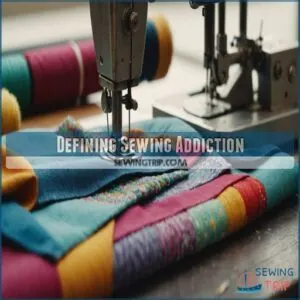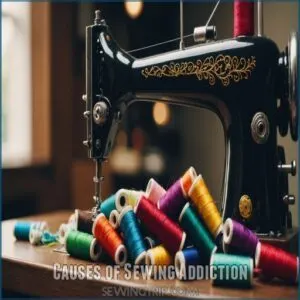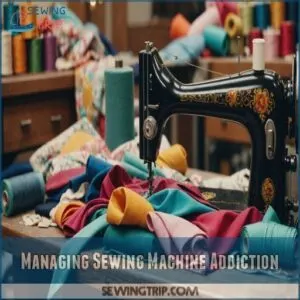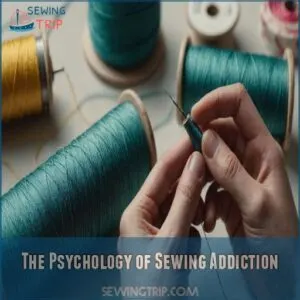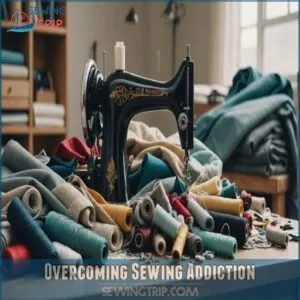This site is supported by our readers. We may earn a commission, at no cost to you, if you purchase through links.
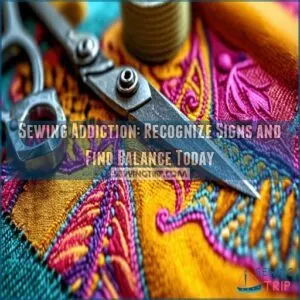 So, you’ve got a sewing addiction? It sounds fun until you’re sleepily stitching at 3 a.m., neglecting everything but your thread collection.
So, you’ve got a sewing addiction? It sounds fun until you’re sleepily stitching at 3 a.m., neglecting everything but your thread collection.
If your dreamworld features bobbins, fabric binges, and a machine louder than a freight train, it’s time to stitch some balance back into your life. Sewing’s the ultimate escape, sure, but turning into a fabric hermit isn’t the goal.
Look for signs—like ignoring relationships and depleting your bank account—to know it’s time for change. Sewing should lift you, not bury you in fabric.
Want to weave balance into your life? Stay tuned for more pointers!
Table Of Contents
- Key Takeaways
- Defining Sewing Addiction
- Causes of Sewing Addiction
- The Appeal of Vintage Sewing Machines
- Managing Sewing Machine Addiction
- The Psychology of Sewing Addiction
- Overcoming Sewing Addiction
- Maintaining a Healthy Sewing Habit
- Embracing a Positive Sewing Lifestyle
- Frequently Asked Questions (FAQs)
- Conclusion
Key Takeaways
- You’re not alone in feeling the pull of sewing addiction; it’s common to find comfort and creative escape in the craft, but balance is crucial to avoid its impact on relationships and finances.
- Recognize the emotional benefits, like stress relief and creative expression, that sewing brings, but be mindful of compulsive behaviors and seek healthier habits or professional help if needed.
- Embrace the charm of vintage sewing machines for their tactile experience and craftsmanship, but avoid hoarding by curating a manageable collection and engaging with the community for support and shared appreciation.
- Maintain a healthy sewing habit by setting boundaries, prioritizing projects, and finding fulfillment in both creating and connecting with others who share your passion.
Defining Sewing Addiction
Ever found yourself elbow-deep in fabric at 2 a.m., convinced you can finish just one more quilt?
If so, you’re not alone; sewing addiction is real, with sewing machines quietly taking over your living room as loving companions that occasionally spark a little household drama.
Signs of Sewing Machine Addiction
Ever found yourself cramming yet another sewing machine into that bulging closet?
You might be dancing on the edge of sewing addiction!
Signs include hoarding machines like trophies, overspending on new models, and losing track of time engrossed in your sewing hobby.
These behaviors can impact family dynamics and mask deeper impulse control issues.
It’s sewing therapy, with a twist!
Emotional Attachment to Sewing Machines
Feeling a tug toward your sewing machine?
It’s not just a tool; it’s a trusted companion packed with sentimental value.
From its nostalgia factor to the craftsmanship appreciation, each machine tells a story.
When sewing, emotional comfort brings a flow state, fueling creative expression and a delightful sense of accomplishment—a charming tapestry of personal history and emotional well-being.
Impact on Daily Life and Relationships
Emotions can run wild when your prized sewing machine takes center stage, leaving relationships in the wings.
Time management wobbles, impulsive buying drains wallets—ouch, the financial burden!
Picture your partner’s face realizing you’re knee-deep in fabric debt.
Social impact? Not quite stitch-perfect.
It’s key to balance sewing with family time, avoiding relationship strain and social anxiety.
Causes of Sewing Addiction
Ever wondered why you’re suddenly surrounded by fabric and sewing patterns?
It’s not just a quirky habit; personality traits, emotional needs, and the influence of social circles can pull you into the delightful yet tangled world of sewing addiction.
Personality Patterns and Traits
Beneath the surface of your sewing passion, are you wrestling with deeper issues?
Do you find yourself exhibiting these traits? 1. A need for control, manifesting as highly organized organization of your sewing space and frequent browsing of sewing pattern websites.
- Perfectionism, leading to frustration when projects don’t meet your impossibly high standards.
- A relentless pursuit of creativity, sometimes bordering on compulsive shopping for supplies.
These patterns, while seemingly harmless, can sometimes indicate a deeper need for control and order.
Coping Mechanisms and Emotional Needs
Think about how sewing becomes your secret getaway from stress, like sipping cocoa by a fire.
Emotional triggers make your creative outlet essential.
With every stitch, you’re crafting both self-esteem and peace, self-soothing your anxiety.
Mindfulness and even a dash of cognitive-behavioral therapy sneak in, helping you manage life’s ups and downs like a pro tailor.
Environmental Factors and Social Influences
Perhaps you’ve found solace in sewing, but let’s explore how the buzz around vintage sewing trends and DIY culture might amplify your passion.
Environmental influences like:
- Sewing communities inspiring new techniques
- Social media fueling the urge to showcase handmade goods
- Thrifting culture promoting sustainability
- Slow fashion encouraging creativity
All these play a part in shaping your sew-ciety!
The Appeal of Vintage Sewing Machines
You can’t help but fall in love with vintage sewing machines; they’re like those quirky relatives who never got the memo that "retro" went out of style.
With their spaceship knobs and funktastic designs, these machines bring a nostalgic charm and a hands-on experience that feels more like crafting with a time-traveling friend than just sewing.
History and Charm of Vintage Machines
When you’re hooked on the vintage sewing machines, it’s not just nostalgia—it’s the rich history whispering tales of innovation and charm.
Brands like Singer and Bernina mastered the sewing arts.
Visit a museum, and you’ll see how design evolved, adding value to these antiques.
Their appeal isn’t just mechanical; it’s a stitch in time.
| Vintage Brands | Design Evolution | Museum Highlights |
|---|---|---|
| Singer | From pedal power | Rare collectibles |
| Bernina | Sleek aesthetics | Restoration focus |
| Pfaff | Durable parts | Hands-on exhibits |
| Elna | Intricate details | Antique appraisals |
| Viking | Simple elegance | Sewing demos |
Tactile Experience and Aesthetic Appeal
Ah, the charm of vintage machines doesn’t just stop at history; it’s all about that tactile experience.
You feel each stitch as if time itself slows down, thanks to their superior feeding mechanisms which provide consistent and precise stitches, giving you that authentic experience with vintage sewing machines’ performance.
A handcrank machine offers a tangible connection, unlike modern electric ones.
Customize your work, and let sewing become art.
After all, in this digital age, who doesn’t love a bit of nostalgia?
Simplicity and Craftsmanship of Vintage Machines
You’re captivated by the tactile joy of vintage machines, aren’t you?
Imagine crafting a masterpiece with nothing but a hand crank—talk about old-school cool!
These machines, masterpieces of simplicity and craftsmanship, bring an irresistible charm that modern gadgets just can’t replicate.
Embrace DIY vintage sewing, and let the hum of history inspire your next sewing project.
Managing Sewing Machine Addiction
So, you’ve got a sewing machine collection that rivals a small museum?
Let’s talk about managing that delightful, slightly overwhelming, possibly-slightly-out-of-control hobby before your spouse starts staging an intervention (kidding…mostly!).
Recognizing The Need for Change
Is your yarn stash starting to resemble an art installation?
Recognizing the need for change can be your eureka moment.
It’s all about balancing time management and avoiding a storage disaster.
Let’s face it, the impact on family space and finances can be overwhelming.
So, ditch the compulsive shopping and find your sewing groove through personal growth and relaxation.
Strategies for Reducing Collection Size
Ever wondered how to tackle that mountain of sewing machines?
Start by prioritizing your favorites and consider selling or donating the rest.
Downsizing offers not just economic benefits but a clearer mind too.
Join a sewing group to share storage tips and sewing psychology insights.
Embrace the freedom of a tidier space and connect with the sewing community!
Finding Alternative Ways to Collect and Appreciate Machines
So you’ve decided to downsize, but miss the thrill of collecting?
Explore machine photography and curate a virtual collection of your favorite vintage gems.
Connect with online communities where fellow enthusiasts share tips on machine restoration and create stunning sewing machine art.
This way, you’ll enjoy your passion without sacrificing space—or sanity!
The Psychology of Sewing Addiction
You might think your growing collection of sewing machines is just a quirky hobby, but it could be more than just a stash of vintage beauties and unstitched dreams!
Understanding the psychology behind sewing addiction can help you balance the emotional and practical benefits, while science offers insights into why this passion sometimes feels a little obsessive.
Emotional Benefits of Sewing and Machine Collecting
Jump right in and discover how sewing brings emotional rewards!
Imagine stitching your stress away—creative outlet at your fingertips.
Here’s why you’ll love it:
- Stress Relief: Find peace as fabric flows through your hands.
- Nostalgia: Relive cherished memories with each stitch.
- Self-expression: Show the world your true colors with unique designs.
Enjoy this dopamine rush!
Practical Benefits of Sewing and Machine Collecting
Feeling creatively fulfilled and wanting more, sewing offers cost-saving thrills and skill-building joys.
You embrace the art of fabric selection and garment construction, each stitch a creative expression.
There’s magic in sewing classes, where community building flourishes.
| Aspect | Benefit |
|---|---|
| Cost-saving | Make your wardrobe |
| Skill-building | Master techniques |
| Creative expression | Unique garments |
The Science Behind Sewing Addiction and Obsessive Behavior
Okay, you’ve mastered the practical benefits; now let’s get real about why you’re hooked.
It’s not just about pretty stitches; it’s about that dopamine release – your brain’s reward system going wild!
But did you know that sewing’s therapeutic effects can sewing help with anxiety by inducing a meditative calm?
Think of it like online shopping addiction, but with more fabric.
Compulsive hoarding? Maybe.
The neurological basis is complex, but treatment options, like cognitive therapy, exist.
Neuroplasticity means you can rewire your brain – ditch the sewing machine obsession and embrace healthier habits!
Overcoming Sewing Addiction
You’re not alone in finding balance with your fabric stash and beloved machines, and the journey can be as rewarding as finishing a quilt without stabbing yourself with a pin!
To overcome sewing addiction, it’s time to stitch in a little self-reflection, explore new hobbies, and maybe even chat with a pro who’s like a life-coach with a tape measure.
Seeking Professional Help and Support
After understanding the psychology behind your sewing addiction, it might be time to call in the professionals.
Getting help isn’t just for sewing machine whispers! Consider:
- Therapy options for new perspectives.
- Support groups to share funny sewing quotes.
- Professional evaluation for personalized advice.
- Financial counseling to keep your wallet happy.
Pivoting toward support can stitch up life’s loose threads!
Developing New Coping Mechanisms and Hobbies
You’ve taken the brave step to seek help—now let’s shake things up with new hobbies.
Swap sewing for stress-relief activities like yoga or painting.
Try mindfulness techniques for a mental breather, or explore textile arts for fun creative outlets.
Mix in time management tricks and healthy habits for a balanced routine that’s more invigorating than a smoothie on a hot day!
Building Healthy Relationships and Communication
Think building habits is tough? Well, welcome to juggling relationships too!
Everyone loves a good sewing t-shirt, but keep communication styles sharp.
Develop fresh coping tactics and watch out for these:
- Boundaries & trust: Without them, you’re sunk.
- Sharing passion: Bond over fabric fun.
- Family support: Stitch new peace through conflict resolution.
You’ve got this!
Maintaining a Healthy Sewing Habit
Maintaining a healthy sewing habit is like making the perfect stitch—finding that sweet spot between collecting fabric treasures and actually creating something fabulous.
So, let’s set some boundaries, mix passion with moderation, and sew a life that’s full of creativity without unraveling your sanity (or your living room).
Setting Boundaries and Priorities
Balancing sewing enthusiasm with real life requires setting priorities—you don’t need your sewing room turning into a fabric jungle!
Tackle time management and keep projects within reason.
Assign financial and emotional limits to avoid a monetary meltdown.
Here’s a little table to ponder:
| Aspect | Consideration |
|---|---|
| Time Management | Allocate sewing time |
| Workspace Limits | Define sewing area |
| Project Selection | Choose wisely |
Finding Balance Between Collecting and Creating
Okay, so you’ve set boundaries, right?
Now, let’s talk about actually using all those gorgeous machines, perhaps with new inspiration from various sewing project tools.
Don’t let them gather dust; that’s a sewing crime!
To keep your sewing space sane and your crafting goals on track, try this:
- Implement a machine rotation system.
- Schedule dedicated sewing time.
- Focus on finishing projects, not just starting them.
Time management is key—and remember, the emotional connection should be with making, not just collecting.
Nurturing a Positive and Fulfilling Sewing Experience
Hey there, sewing maestro. With sewing being a good hobby for therapy, craft a sewing routine that’s as joyous as your favorite needle and thread combo. Embrace creative inspiration and lock in your sewing goals, which can also help with anxiety relief and improve cognitive function as discussed in the benefits of Sewing Therapy for Wellness.
Need a lifeline? Lean on community support.
| Tip | Benefit |
|---|---|
| Time management | Less stress |
| Mental wellbeing | More joy |
| Set sewing goals | Achieve mastery |
Sew on, savvy creator!
Embracing a Positive Sewing Lifestyle
When your sewing projects start becoming less about the threads and more about the therapy, it’s time to embrace the joy of creating.
Invite your quirky creations to take center stage.
Build a tapestry of supportive friends who "get it".
Throw a little dance party each time you finish a masterpiece.
Focusing on The Joy of Sewing and Creating
Why not embrace the soothing rhythm of sewing as therapy?
Jump into creative expression with each stitch, transforming fabric into joys of slow fashion.
With the right sewing tools online, you can bring your imagination to life.
Imagine crafting for charity, adding purpose to your passion!
Let your sewing machine be the maestro, conducting a symphony of threads.
Feel the liberation as threads weave your dreams into tangible creations, one stitch at a time.
Building a Supportive Community and Network
You’re falling in love with the sewing journey, but remember, it’s more fun with friends!
Joining sewing meetups, engaging in online forums, and taking local classes lets you share and learn.
Share projects, create collaborative masterpieces, and watch the support flow.
It’s like a stitch—a little effort, yet it holds the fabric of your community together!
Celebrating Progress and Achievements
Think of sewing as an epic adventure and mastering essential embroidery tools and stitches can be a major milestone.
Celebrate every button sewn and seam stitched, for they’re your milestones.
Take pride in your creations—whether it’s a quirky quilt or a snazzy skirt.
Your skill growth is like leveling up in a game.
Share triumphs with your community, and remember, it’s not just sewing; it’s self-improvement with flair!
Frequently Asked Questions (FAQs)
Is sewing good for mental health?
Ever feel like a tangled ball of yarn?
Sewing can untangle stress!
It’s a fantastic mental workout, boosting creativity and focus.
Plus, stitching a project to life provides a sense of accomplishment and relaxation.
Is knitting addictive?
Knitting can be surprisingly addictive, kind of like that friend who swore they’d quit coffee.
The rhythmic click of needles, watching rows magically grow, hooks you.
Soon, you’ll find yourself pondering yarns like exotic treasures.
What happens if a person is addicted to shopping?
Imagine you’re swimming in a sea of shopping bags—fun, right?
But wait, it leads to guilt, financial strain, and endless clutter.
Regret follows the thrill, leaving you drowning in bills and emotional distress.
Is sewing a coping method?
Sewing’s a fantastic coping method, letting you stitch away stress while making something beautiful.
It’s like crafting your peace one stitch at a time.
Bonus? It keeps hands busy and mind calm, almost meditative!
Why do I like sewing so much?
Last week, my friend spent hours perfecting her jacket.
You might love sewing because it gives you control, creativity, and relaxation.
It’s your way to make something unique, like an artist with fabric instead of paint.
Why is sewing so therapeutic?
You sew, and it’s like therapy with fabric.
Every stitch pulls you into a calming rhythm, easing stress.
Creating something tangible boosts your confidence and satisfaction—better than a chocolate binge, and your pants still fit!
What are the psychological benefits of sewing?
Get into sewing; it’s a creativity booster! You’ll find stress melts away, focus sharpens, and self-esteem soars with each stitch. It’s pure therapy, my friend!
Is sewing good for anxiety?
Imagine taming anxiety with a sewing needle!
Sewing soothes the mind, offering rhythmic motion like meditation.
It transforms nerves into focus, letting creativity flow while quieting those inner storms.
Plus, finished projects are miniature victories against stress!
How much space does sewing require?
Did you know a cozy nook, as small as 5 feet by 5 feet, can suffice for sewing?
Toss in a chair, add a table for your machine, and thread your way to creativity without a hitch!
What are good starter sewing projects?
Start with simple sewing projects like cushion covers, tote bags, or pillowcases.
They’re not rocket science!
These projects help you master basic skills like stitching straight and using patterns, all while boosting your crafty confidence.
Have fun!
Can sewing be a profitable hobby?
Sure, sewing can totally bring in some cash!
Craft unique garments, quilts, or home decor to sell online or at local markets.
Plus, custom orders can fill your pockets with green while you’re having a blast!
Where can I find affordable sewing supplies?
Discover budget-friendly sewing supplies at thrift stores, online marketplaces like eBay, or fabric store clearance sections.
Check out community forums or Facebook groups for swaps and sales.
Don’t overlook garage sales for vintage treasures!
Is sewing machine repair expensive?
Imagine this: your sewing machine’s breakdown isn’t the end of the road.
Costs vary like stitches; simple fixes can be cheap, while major repairs leave a dent.
Local repair shops or DIY can save you that extra cash.
Conclusion
Ultimately, remember that a sewing addiction, while fun, can easily unravel your life.
It’s like a delicious cake – you can enjoy a slice, but the whole thing? That’s a recipe for disaster!
So, find your balance.
Set limits on your fabric shopping sprees, maybe even ditch a few machines.
Prioritize your relationships and your well-being.
A happy, balanced you is the best accessory you can sew into your life.
You deserve it!
And remember, a well-organized sewing room is a happy sewing room.

